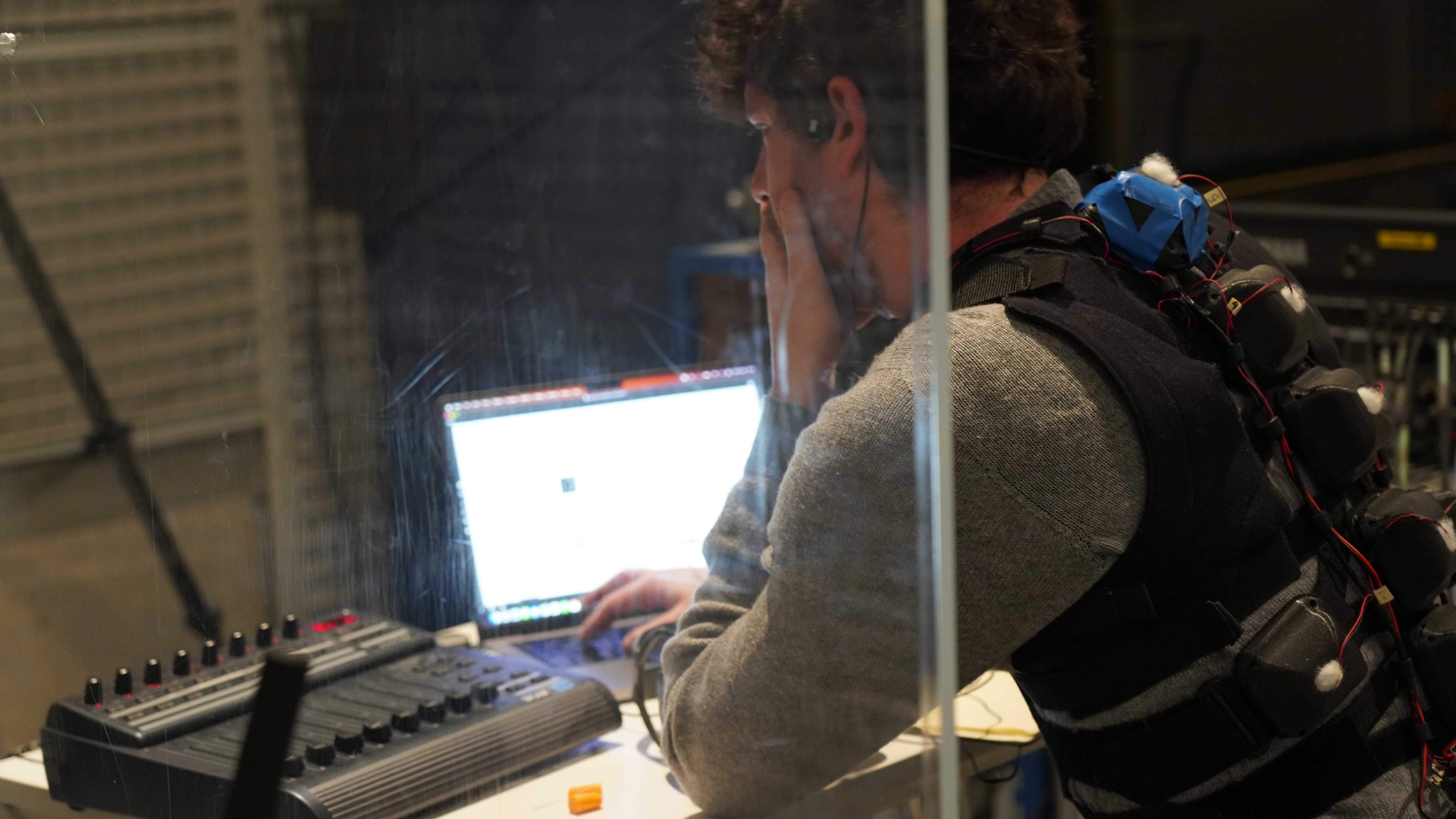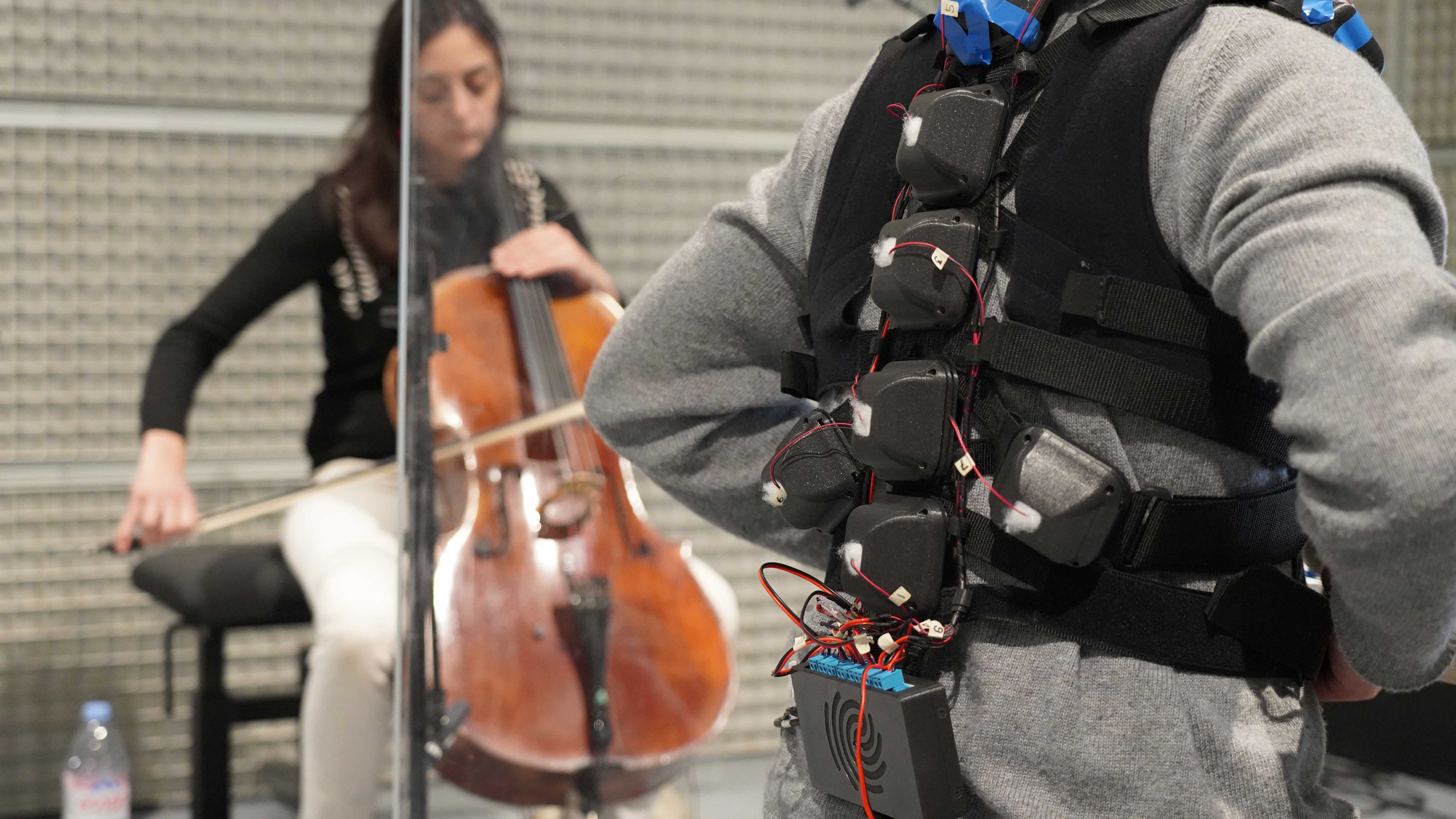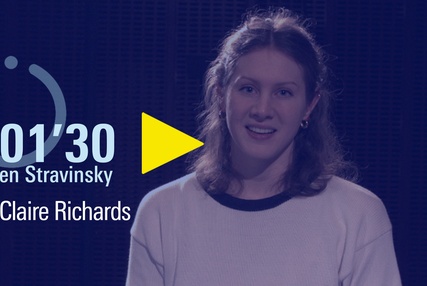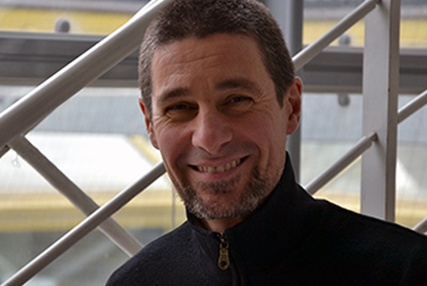En ce début d’année 2024, une nouvelle résidence en recherche artistique est lancée dans les sous-sols de l’Ircam. Le compositeur italien Alberto Gatti s’empare d’une nouvelle technologie de diffusion sonore un peu particulière et, surtout, au plus près du corps.
Compositeur, sound-designer et RIM italien formé initialement au conservatoire de Florence, Alberto Gatti trouve rapidement dans la musique électronique son mode d’expression privilégié. Cependant, dès ses premiers pas en tant que compositeur acousmatique, et plus encore au cours de son master de recherche artistique AReMus au conservatoire de Rome, il aspire explorer d’autres modes de diffusion que celui, ultra dominant, qu’est le haut-parleur. « Désireuse de s’abstraire de l’instrument acoustique, la musique électronique s’est développée dans la culture du haut-parleur, résume-t-il. Ma propre pratique m’a amené à explorer des alternatives, et notamment ce que j’appelle des "objets instrumentaux". Ce sont la plupart du temps des objets trouvés, parfois lumineux, sur lesquels je fixe des transducteurs. Ce travail m’a poussé à développer une réflexion sur les liens entre l’objet et le son, ainsi qu’entre le corps et le son. »
Alberto Gatti en est là de ses réflexions lorsque, à l’issue de son master romain, il fait un stage à l’Ircam. Là, il fait la rencontre de Claire Richards, doctorante américaine au sein de l’équipe Perception et design sonores (PDS) du laboratoire STMS, dont les recherches portent justement sur la perception modale du son. Dans le cadre de sa thèse codirigée par Nicolas Misdariis, chef de l’équipe PDS, et Roland Cahen, Claire Richards a mis au point et développé un dispositif de diffusion sonore très original : un harnais qui ressemble plus à un instrument de torture ou à un dispositif médical. Embarquant divers transducteurs placés de manière à entrer en contact avec des points stratégiques du squelette, ce harnais est un dispositif de diffusion sonore à conduction osseuse — à l’instar de ces casques de plus en plus répandus, qui diffusent les vibrations sonores jusqu’à l’oreille interne via les os du crâne, en court-circuitant le tympan.

Le harnais doit être parfaitement ajusté sur le sujet. Il embarque neuf transducteurs : cinq répartis sur la colonne vertébrale, deux sur les côtes, deux sur les clavicules. Sans être véritablement inconfortable, le port du harnais évoque un peu les corsets d’antan. En revanche, passées les premières impressions de chatouille, la sensation de vibration générale (comme un frisson provoqué qui parcourrait l’échine) est saisissante, tout comme celle d’être transpercé par les impacts lorsque le dispositif diffuse les sons d’un instrument de percussion, par exemple.
 La violoncelliste Marie Ythier et Alberto Gatti en studio à l'Ircam
La violoncelliste Marie Ythier et Alberto Gatti en studio à l'Ircam
Les transducteurs font chacun vibrer un os : on « sent » donc le son, de manière tactile, mais la vibration voyage également par contact, d’os en os, dans le corps, jusqu’à la cochlée[1] qui vibre à son tour. La perception du son se fait donc à la fois par l’ouïe et par le toucher. « On « ferme » aussi les oreilles de l’auditeur, précise Alberto Gatti, au moyen de boules Quiès et d’un casque à réduction active de bruit : on s’est en effet aperçu que, sinon, le sujet est moins sensible à ses sensations corporelles, et l’expérience est moins intéressante. Lors de mes premières expériences dans le cadre de ce stage, j’ai pu faire un test avec la violoncelliste Marie Ythier: c’était fabuleux. Je n’entendais pas le son, mais j’avais le sentiment qu'elle jouait de mon propre corps ! »
Toujours au cours de ce stage, Alberto Gatti a contribué au développement d’un outil de composition destiné à spatialiser la diffusion sonore dans le harnais. Il en a également profité pour composer trois « Études » électroacoustiques audio-tactiles :
« Je savais déjà que le tactile était une dimension extrêmement importante du jeu musical pour l’interprète, mais je n’aurais jamais imaginé l’importance de cette composante pour l’auditeur, dit-il. »
Ces premières expériences donnent évidemment envie au jeune compositeur d’approfondir la chose. D’où sa candidature à une résidence en recherche artistique, intitulée Re-sounding bodies (corps ré-sonnants), dont l’objectif premier est d’effectuer divers tests et analyses, afin de déterminer les meilleures conditions pour la diffusion des sons par le biais de ce harnais, en relation ou non à un geste instrumental. Éprouver ce qui fonctionne, ou pas.
« Par exemple, dit Alberto Gatti, on sait que l’oreille humaine peut percevoir des fréquences entre 20Hz et 20000Hz. Avec ce dispositif, c’est plutôt entre 70Hz et 1200Hz. Cependant, dans les graves, on « ressent » le son avec le corps plus qu’on ne l’entend. Plus on va vers l’aigu, plus le son « remonte » vers l’oreille : on l’entend de plus en plus et on le ressent de moins en moins. Résultat : on a le sentiment que le son se déplace du bas du corps, quand c’est tactile et grave, vers le haut du corps et la tête, quand c’est aigu. Et 250Hz semble être la fréquence idéale pour toucher les deux sens à égalité. Naturellement, d’une personne à l’autre, les sensations sont très variées. »
« C’est justement cet aspect multimodal de la perception sonore que je voudrais explorer dans le cadre de cette résidence, en reliant son et geste, mais aussi son et toucher, et en approfondissant la dimension charnelle, à l’intérieur du corps, de ce nouveau mode d’écoute. Comment spatialiser au mieux les sons dans le harnais, non seulement pour qu’on les ressente au mieux, mais surtout pour qu’ils se mettent au service d’un discours musical ? Et que se passe-t-il quand la source sonore n’est pas abstraite, comme dans le cas d’un discours acousmatique, mais quand on voit l’interprète ? L’interprète peut-il, comme je l’ai moi-même ressenti avec le violoncelle, « jouer » avec le corps du spectateur, et comment ?
Peut-il nous « toucher » sans nous toucher ? C’est le sens du titre « Re-sounding bodies » que j’ai donné à ma résidence en recherche artistique. Et si ce ne sont plus des instruments, mais des objets instrumentaux, comme une table, une boite, etc. ? Et si le son que l’on ressent est décorrélé de celui que l’on voit ? »
Autre piste : au lieu de « boucher » les oreilles de l’auditeur, pourquoi ne pas lui mettre un casque à conduction osseuse également, pour l’immerger dans une sphère de son ? L’idée, à terme, étant par exemple de donner, avec le harnais et le casque combinés, une nouvelle dimension à la diffusion sonore, pour de la musique, bien sûr, mais aussi pour des films…
Le but ultime, enfin, est bien entendu de composer avec et pour le dispositif.

[1] Partie de l'oreille interne enroulée en spirale, contenant les terminaisons du nerf auditif.




 La violoncelliste Marie Ythier et Alberto Gatti en studio à l'Ircam
La violoncelliste Marie Ythier et Alberto Gatti en studio à l'Ircam


